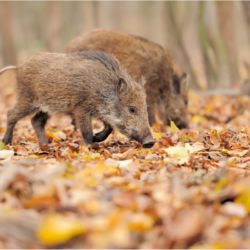Herpes B, also known as virus B or Herpesvirus simiae, is a rare zoonotic virus that is potentially fatal to humans. Originating in macaques, it can cause serious infections in people exposed through bites, scratches or contact with the secretions of infected monkeys. Although rare, herpes B infection in humans requires urgent medical attention. It can lead to serious neurological complications and has a high mortality rate.
In animal health, monkey herpes virus B, or Herpesvirus simiae, is a disease known to be contagious. In public health terms, it is not a notifiable human disease. It is not currently classified as an occupational disease. However, monkey herpes virus B is classified in hazard group 3 (R. 231-61-1 of the French Labour Code). This indicates a high risk of transmission and seriousness for humans, requiring strict precautionary measures when handling potentially infected animals.
What virus is responsible?
Herpesvirus simiae (monkey herpes virus B) is different from human herpes viruses (herpesvirus hominis). The herpes B virus, or Macacine alphaherpesvirus 1, belongs to the Simplexvirus genus and the Herpesviridae family. This neurotropic virus is pathogenic for humans and can cause severe, often fatal, meningoencephalitis. It is related to human herpes viruses type 1 and 2(HHV-1 and HHV-2), and is highly prevalent in macaques.
Herpes B virus is an enveloped linear double-stranded DNA virus 120 to 200 nm in diameter, structurally similar to HSV1 and HSV2. The envelope glycoproteins show serological cross-reactivity with these viruses. The nucleocapsid of the herpes B virus, made up of 6 proteins, is icosahedral (T = 16.
The envelope, which is loose around the viral capsid, contains at least 10 glycoproteins. These glycoproteins are essential for adsorption and penetration of host cells. The integument, located between the capsid and the envelope, contains at least 14 viral proteins. These proteins play a role in nucleic acid metabolism, DNA synthesis and protein processing.
In 2003, scientists sequenced the entire genome of the herpes B virus from an isolate extracted from a rhesus macaque. Like all herpes viruses, it contains double-stranded DNA of around 157 KpB. Sequence analysis suggests that herpes B virus and HSV types 1 and 2 share a common ancestor. Each gene-encoded glycoprotein shows approximately 50% homology with HSV.
It has a genome rich in guanine and cytosine (75%). This suggests secondary glycoprotein structures similar to those of HHV. The behaviour of CeHV-1 in cell culture is similar to that of HHV-1, with an identical viral multiplication cycle.
How does the disease manifest itself in animals?
Monkeys, mainly macaques, can be infected with the herpes B virus. Infection is common in macaques in Asia, particularly in Macaca mulatta (rhesus monkey) and Macaca fascicularis (crab monkey). The cynomolgus macaques of Mauritius are reputed to be free of the disease. The virus is found in over 80% of adult macaques in Asia and Africa, sometimes reaching 100% in certain areas. However, it has not been detected in American or Madagascan monkeys.
The herpes B virus is transmitted sexually, by bite or scratch. It can also be transmitted by air (droplets of saliva). In macaques, infection is often asymptomatic. In some cases, vesicles or mouth ulcers may appear in the mouth, on the lips, or on the genital and conjunctival mucosa. In other monkeys, the infection can be fatal, affecting the central nervous system.
Primary infection in macaques often manifests itself as conjunctivitis or oropharyngeal infection. Most infected macaques are healthy carriers. However, certain stressful events (surgery, parturition, long transport, environmental changes, etc.) can reactivate the virus. This encourages excretion and increases the risk of transmission. The main sources of infection are secretions from the upper airways, saliva, cerebrospinal fluid and skin vesicles.
The herpes B virus is prevalent in Old World macaque monkeys of Asian origin and can reactivate in the event of stress, leading to elimination via saliva.
How is it transmitted?
Transmission of herpes B from a captive monkey is mainly by bite, scratch or prick with soiled equipment. It is also transmitted through the eyes when a contaminated hand touches the eyes or when saliva is splashed into the eyes. Since 1932, the authorities have reported fewer than 40 cases of human infection worldwide.
Professional activities at risk include any work in the presence of monkeys, particularly from Asia and Africa, or samples taken from monkeys, such as :
- Animal houses in research laboratories
- Veterinary care
- Research laboratories
- Rendering services
- Zoos and animal parks
Herpes virus B is transmissible to humans. The victims of this zoonosis are mainly vets, staff at primatology centres, pet shops or laboratories, renderers and people working in zoos or circuses. Contamination occurs mainly through bites, scratches or exposure of skin lesions, mucous membranes or eyes to infected secretions or biological samples. The virus is extremely contagious and can be transmitted by a simple scratch.
Handling contaminated objects, such as cages, has resulted in a few rare transmissions to humans. This includes one case involving the handling of a rhesus macaque skull. Professionals have reported a single case of human-to-human transmission. This case resulted from contact between a crab-eating macaque bite wound and a pre-existing skin lesion.
Since the identification of the B virus in 1932, documents show that 50 people have been infected, with 21 deaths. Carrier animals are particularly contagious when they are first infected or when the virusreactivates. A simple scratch can be enough to pass the virus from monkeys to humans. All carrier animals should be considered as potentially contagious.
What does herpes B look like in humans?
The first symptoms of herpes B infection appear between 2 days and 6 weeks after infection. They include itching and lymphadenopathy near the site of inoculation. The infection rapidly manifests itself as a fever, sometimes accompanied by vesicular eruptions, widespread pain,numbness in the extremities, tingling and other neurological disorders.
If left untreated, symptoms progress to headaches, nausea, dizziness, loss of consciousness, urinary retention, respiratory distress, hemiplegia and progressive ascending paralysis. This often leads to meningoencephalitis by spreading along the nervous system, via the spinal cord to the brain. This can lead to coma. Most untreated cases result in severe and disabling neurological sequelae or death.
The incubation period for the virus varies from 3 days to 4 weeks. After inoculation, the virus spreads along the central nervous system to the spinal cord and brain. This causes ascending necrosis.
Clinically, the infection presents as febrile ascending encephalomyelitis, with a vesicular skin reaction at the site of the bite and paralysis of the respiratory centres. In 70% of cases, the disease leads to death or major sequelae in survivors. Initial symptoms often include pruritus at the bite site, vesicles and lymphadenopathy, followed by a flu-like syndrome before the onset of neurological disorders.
How is this condition diagnosed?
Diagnosis of herpes virus B (CHV-1) infection is mainly made by PCR (identification of the herpes virus B genome) from skin lesions, cerebrospinal fluid, or during clinical manifestations and necropsy. This test is not available in France. Methods for detecting CHV-1 include :
- Culture of the agent obtained from swab samples, cerebrospinal fluid and biopsy material from points of infection (bites and scratches)
- Polymerase chain reaction (PCR)
- ELISA test
- Western blot
- PCR-hybridisation on microplate
Due to high cross-reactivity with herpes simplex virus types 1 and 2, human serum tests are of limited diagnostic value.Magnetic resonance imaging (MRI), computed tomography (CT) and electroencephalogram (EEG) can be used to detect neurological signs of CHV-1 infection. Diagnostic methods are not available in all countries. The mortality rate in untreated patients is 70-80%.
People who are bitten or attacked are at high risk if the wound is deep, localized to the face, neck, chest or hands, or if it is caused by a deep puncture wound. Exposure to nerve tissue, tears, saliva, urine or faeces, as well as genital secretions or eye splashes, also increases the risk. The risk is lower in the case of an AES because there is no viremia.
How is it treated?
If there is a wound, it is vital to wash it for 15 to 20 minutes with a solution of NH4, polyvidone-iodine or chlorhexidine. For eye lesions, irrigation with an ocular or saline solution is necessary for 15 minutes.
In the event of a bite, scratch or contact of injured skin or a mucous membrane with secretions from a contaminated animal, the wounds and contact areas must be washed immediately with soap. Allow to bleed under running water. Rinse thoroughly, disinfect and consult a doctor as a matter of urgency. Within a few hours of the incident, the doctor should prescribe specific antiviral medication for a period of 3 weeks.
Doctors use aciclovir, valaciclovir or ganciclovir infused in a specialised environment for several months if symptoms appear. The case-fatality rate is over 60%, even with appropriate treatment, and close to 80% in untreated people.Relapses are possible if treatment is stopped early.
The frequency of immunity to herpes B virus is unknown, and immunity to human herpes does not protect against monkey herpes B virus. There is no vaccine available.
Tetanus and rabies must be systematically considered and prevented. Preventive treatment against herpes B should be started as soon as possible, ideally within 48 hours. A first-use kit containing valaciclovir should be available in laboratories.
Antiviral prophylaxis includes aciclovir, valaciclovir and ganciclovir for a minimum of 14 to 21 days. In the event of neurological signs or evidence of viral infection, treatment should be continued until virological tests are negative, sometimes for several years according to the American literature.
What preventive measures are available?
There is no vaccine available. In addition, immunity against HSV1 and HSV2 does not protect against the herpes B virus. In addition to import health regulations, the main means of prevention include scrupulous hygiene of working equipment, such as monkey cages, and systematic isolation of suspect specimens, followed by serological checks. Wearing appropriate gloves and eye protection also reduces the risk of contamination. It is advisable to avoid approaching potentially infected monkeys when travelling in these regions.
To prevent infection in humans, rigorous general hygiene must be maintained. This includes cleaning and disinfecting premises and equipment. It is also essential to store animal waste and cadavers in refrigerated containers. Employees must receive appropriate training on the risks associated with herpes B and on preventive measures.
If herpes B is suspected in a monkey, control measures include isolating suspected monkeys, carrying out serological tests and euthanising them if infection is confirmed. Professionals must also serologically test monkeys in contact with the suspect monkey. Managers restrict access to theisolation site to essential professionals only, and wash and disinfect contaminated sites.
To reduce possible sources of contamination, wear long-sleeved clothing, a face shield or surgical masks and goggles, as well as resistant gloves when caring for animals. Clean up animal droppings with care and handle corpses or animal waste with impervious gloves.
If you are bitten, scratched or injured, seek immediate medical advice from a doctor familiar with herpes B.
Some epidemiological data…
Scientists first identified the herpes B virus in 1932, after the death of Dr William Brebner, a young doctor infected by a monkey bite while researching the poliomyelitis virus. After the bite, Brebner developed erythema, lymphangitis, lymphadenitis and finally transverse myelitis. Neurological tissue from his autopsy revealed an agent similar to HSV.
A year later, Dr Albert Sabin identified this agent and named it Virus B. Gay and Holden named it W Virus after Brebner. Sabin demonstrated that the virus is lethal, whatever the route of inoculation. He also showed that herpes B induces immunological responses similar to HSV-1 and shares similarities with HVP-2 and Langur herpesvirus.
In 1959, researchers identified herpes B virus as the causative agent of 17 human cases, 12 of which were fatal. The National B Virus Resource Center at Georgia State University reported the last cases in 2008. New cases appeared in 2021 in China.
Since 1932, specialists have described around 50 cases, including 21 deaths. Most infections have occurred following bites, scratches or percutaneous exposure in a laboratory setting.
In 2021, China reported the first human infection with the herpes B virus in a 53-year-old veterinary surgeon in Beijing. He died after dissecting monkeys. Then, in April 2024, the Hong Kong health authorities reported a new case in a 37-year-old man who had been injured by wild monkeys. He is currently in intensive care, with a sample of cerebrospinal fluid testing positive for the virus.
Cases of herpes B have also been reported in the United States, Canada, Japan (first case in 2019) and mainland China (first case in 2021). The virus is not transmitted from one human to another. However, it represents a zoonotic threat for workers in contact with monkeys.





